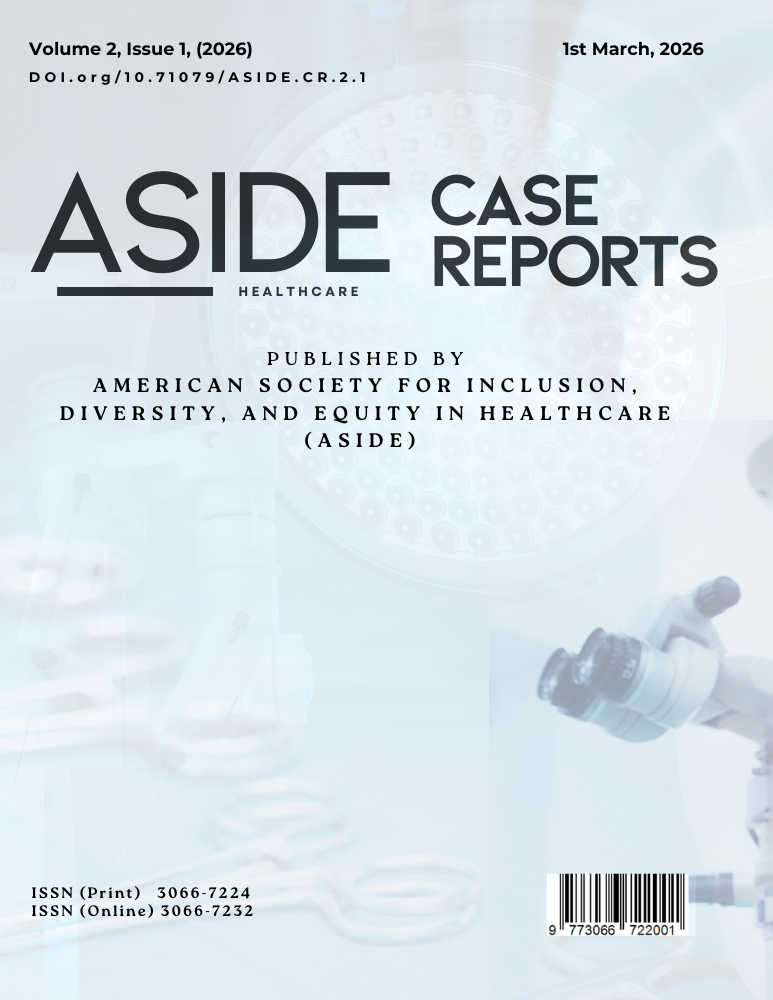Abstract
Amiodarone-induced thyrotoxicosis (AIT) is a subtype of thyrotoxicosis caused by the long-term administration of the antiarrhythmic drug amiodarone. It’s classified into type 1 AIT, which is defined as hypersecretion of the thyroid hormone, while type 2 AIT is destructive thyroiditis leading to increased release of thyroid hormone. Each type has its special management and diagnostic features. We report a case of a 72-year-old male with a history of heart failure with reduced ejection fraction (HFrEF) and type 2 diabetes mellitus (DM) who presented with congestive heart failure (CHF) exacerbation and symptoms of an impending thyroid storm. After the diagnosis of type 2 AIT, medical treatment, as well as plasmapheresis, was initiated. In further admissions, the patient returned with ventricular tachycardia and right subclavian deep venous thrombosis due to recurrent catheterization and a hypercoagulable state. The diagnostic workup revealed elevated free T4, suppressed TSH, and initially elevated AST and ALT, which normalized subsequently. Imaging showed decreased thyroid vascularity. This case report highlights the importance of distinguishing between AIT types, tailoring optimal treatment decisions, closely monitoring and following up on such cases, and adhering to treatment to prevent catastrophic complications. Further research is necessary to identify early markers of amiodarone toxicity to prompt early diagnosis and better prognosis.
References
1. Khan A, Puttanna A, Raskauskiene D. Amiodarone-induced thyrotoxicosis: type 1 or type 2? BMJ Case Rep. 2014: [PMID: 25349184, https://doi.org/10.1136/bcr-2014-204485]
2. Chua MWJ, Mok SF. Amiodarone Induced Thyrotoxicosis and Treatment Complications in a Man With Cyanotic Congenital Heart Disease: A Case Report. Front Cardiovasc Med. 2020: 574391 [PMID: 33330642, https://doi.org/10.3389/fcvm.2020.574391]
3. Macchia PE, Feingold KR. Amiodarone Induced Thyrotoxicosis. In: Feingold KR, Ahmed SF, Anawalt B, Blackman MR, Boyce A, Chrousos G, Corpas E, de Herder WW, Dhatariya K, Dungan K, Hofland J, Kalra S, Kaltsas G, Kapoor N, Koch C, Kopp P, Korbonits M, Kovacs CS, Kuohung W, Laferrere B, Levy M, McGee EA, McLachlan R, Muzumdar R, Purnell J, Rey R, Sahay R, Shah AS, Singer F, Sperling MA, Stratakis CA, Trence DL, Wilson DP, editors. Endotext. South Dartmouth (MA): MDText.com, Inc.
Copyright © 2000-2025, MDText.com, Inc.; 2000.
4. Bogazzi F, Bartalena L, Martino E. Approach to the patient with amiodarone-induced thyrotoxicosis. J Clin Endocrinol Metab. 2010: 2529 [PMID: 20525904, https://doi.org/10.1210/jc.2010-0180]
5. Narayana SK, Woods DR, Boos CJ. Management of amiodarone-related thyroid problems. Ther Adv Endocrinol Metab. 2011: 115 [PMID: 23148177, https://doi.org/10.1177/2042018811398516]
6. Tsang W, Houlden RL. Amiodarone-induced thyrotoxicosis: a review. Can J Cardiol. 2009: 421 [PMID: 19584973, https://doi.org/10.1016/s0828-282x(09)70512-4]
7. Barrett B, Hawkes CP, Isaza A, Bauer AJ. The Effects of Amiodarone on Thyroid Function in Pediatric and Young Adult Patients. J Clin Endocrinol Metab. 2019: 5540 [PMID: 31361319, https://doi.org/10.1210/jc.2019-00990]
8. Takemoto K, Takada S. Thyroid storm associated with type 2 amiodarone-induced thyrotoxicosis due to long-term administration: a case report. Acute Med Surg. 2020: e616 [PMID: 33335740, https://doi.org/10.1002/ams2.616]
9. Middeldorp ME, Elliott AD, Gallagher C, Linz D, Hendriks JML, Mahajan R, Lau DH, Sanders P. Late-onset thyrotoxicosis after the cessation of amiodarone. Indian Pacing Electrophysiol J. 2020: 265 [PMID: 32745519, https://doi.org/10.1016/j.ipej.2020.07.006]
10. Upadhyaya VD, Douedi S, Akula M, Chalasani KK, Saybolt MD, Hossain M. Amiodarone-Induced Thyroid Storm Causing Sustained Monomorphic Ventricular Tachycardia Treated With Plasmapheresis: A Challenging Clinical Case. J Med Cases. 2020: 79 [PMID: 34434369, https://doi.org/10.14740/jmc3450]
11. Mercado M, Mendoza-Zubieta V, Bautista-Osorio R, Espinoza-de los Monteros AL. Treatment of hyperthyroidism with a combination of methimazole and cholestyramine. J Clin Endocrinol Metab. 1996: 3191 [PMID: 8784067, https://doi.org/10.1210/jcem.81.9.8784067]
12. Zacharia JA, May TL. The perils of beta-blockade and the promise of venoarterial extracorporeal membrane oxygenation in managing low-output heart failure in thyroid storm: a case report. Journal of Emergency and Critical Care Medicine. 2021: 37 https://doi.org/10.21037/jeccm-20-133]
13. Miller A, Silver KD. Thyroid Storm with Multiorgan Failure Treated with Plasmapheresis. Case Rep Endocrinol. 2019: 2475843 [PMID: 31687222, https://doi.org/10.1155/2019/2475843]
14. Moazezi T, Koh CK. The Use of Plasmapheresis in a Severe Case of Amiodarone-Induced Thyrotoxicosis. JCEM Case Rep. 2023: luad123 [PMID: 37942132, https://doi.org/10.1210/jcemcr/luad123]
15. Vinan-Vega M, Mantilla B, Jahan N, Peminda C, Nugent K, Lado-Abeal J, Rivas A. Usefulness of plasmapheresis in patients with severe complicated thyrotoxicosis. Proc (Bayl Univ Med Cent). 2020: 279 [PMID: 33678963, https://doi.org/10.1080/08998280.2020.1852007]
16. Niveditha K, Menon AS, Kumar H, Eapen M, Gopalakrishna R. A case of acute liver injury induced by methimazole. Thyroid Research and Practice. 2021: 34 https://doi.org/10.4103/trp.trp_73_20]
17. Klein I, Danzi S. Thyroid disease and the heart. Circulation. 2007: 1725 [PMID: 17923583, https://doi.org/10.1161/CIRCULATIONAHA.106.678326]
18. Pokhrel B, Aiman W, Bhusal K. Thyroid Storm. StatPearls. Treasure Island (FL): StatPearls Publishing
Copyright © 2025, StatPearls Publishing LLC.; 2025.
19. Dietrich JW, Muller P, Leow MKS. Editorial: Thyroid hormones and cardiac arrhythmia. Front Endocrinol (Lausanne). 2022: 1024476 [PMID: 36147578, https://doi.org/10.3389/fendo.2022.1024476]
20. Ahmad M, Reddy S, Barkhane Z, Elmadi J, Satish Kumar L, Pugalenthi LS. Hyperthyroidism and the Risk of Cardiac Arrhythmias: A Narrative Review. Cureus. 2022: e24378 [PMID: 35619859, https://doi.org/10.7759/cureus.24378]
21. Lin HC, Yang LY, Kang JH. Increased risk of pulmonary embolism among patients with hyperthyroidism: a 5-year follow-up study. J Thromb Haemost. 2010: 2176 [PMID: 20738759, https://doi.org/10.1111/j.1538-7836.2010.03993.x]
22. Mehta AN, Vallera RD, Tate CR, Sager RA, Welch BJ. Total thyroidectomy for medically refractory amiodarone-induced thyrotoxicosis. Proc (Bayl Univ Med Cent). 2008: 382 [PMID: 18982079, https://doi.org/10.1080/08998280.2008.11928432]
23. Kotwal A, Clark J, Lyden M, McKenzie T, Thompson G, Stan MN. Thyroidectomy for Amiodarone-Induced Thyrotoxicosis: Mayo Clinic Experience. J Endocr Soc. 2018: 1226 [PMID: 30370394, https://doi.org/10.1210/js.2018-00259]

This work is licensed under a Creative Commons Attribution 4.0 International License.
Copyright (c) 2025 Ahmed Sobhy, Mahmoud Abd El-Nasser, Noha Hammad, Tasnim Tarboush, Ahmed Hassan, Genevieve Kela


